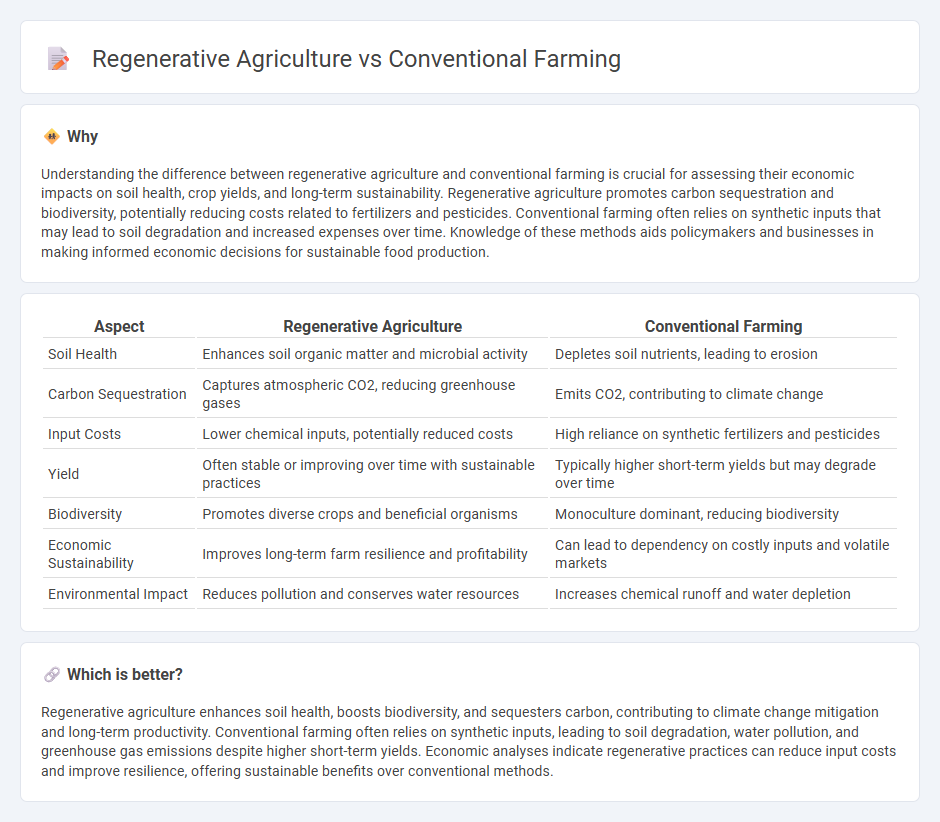
Regenerative agriculture enhances soil health, biodiversity, and carbon sequestration compared to conventional farming, which often depletes nutrients and relies heavily on chemical inputs. Economic benefits of regenerative practices include reduced input costs and improved long-term productivity, while conventional methods may offer higher short-term yields but at environmental and financial risks. Explore how these contrasting approaches impact sustainable economic growth and food security.
Why it is important
Understanding the difference between regenerative agriculture and conventional farming is crucial for assessing their economic impacts on soil health, crop yields, and long-term sustainability. Regenerative agriculture promotes carbon sequestration and biodiversity, potentially reducing costs related to fertilizers and pesticides. Conventional farming often relies on synthetic inputs that may lead to soil degradation and increased expenses over time. Knowledge of these methods aids policymakers and businesses in making informed economic decisions for sustainable food production.
Comparison Table
| Aspect | Regenerative Agriculture | Conventional Farming |
|---|---|---|
| Soil Health | Enhances soil organic matter and microbial activity | Depletes soil nutrients, leading to erosion |
| Carbon Sequestration | Captures atmospheric CO2, reducing greenhouse gases | Emits CO2, contributing to climate change |
| Input Costs | Lower chemical inputs, potentially reduced costs | High reliance on synthetic fertilizers and pesticides |
| Yield | Often stable or improving over time with sustainable practices | Typically higher short-term yields but may degrade over time |
| Biodiversity | Promotes diverse crops and beneficial organisms | Monoculture dominant, reducing biodiversity |
| Economic Sustainability | Improves long-term farm resilience and profitability | Can lead to dependency on costly inputs and volatile markets |
| Environmental Impact | Reduces pollution and conserves water resources | Increases chemical runoff and water depletion |
Which is better?
Regenerative agriculture enhances soil health, boosts biodiversity, and sequesters carbon, contributing to climate change mitigation and long-term productivity. Conventional farming often relies on synthetic inputs, leading to soil degradation, water pollution, and greenhouse gas emissions despite higher short-term yields. Economic analyses indicate regenerative practices can reduce input costs and improve resilience, offering sustainable benefits over conventional methods.
Connection
Regenerative agriculture enhances soil health and biodiversity, directly impacting the productivity and sustainability of conventional farming by improving crop yields and reducing input costs. Conventional farming practices often rely on synthetic fertilizers and pesticides, whereas regenerative methods focus on natural processes, creating a complementary relationship that can drive economic resilience in the agricultural sector. This integration supports long-term economic growth by promoting sustainable resource use and reducing environmental degradation.
Key Terms
Input Costs
Conventional farming often involves high input costs due to reliance on synthetic fertilizers, pesticides, and heavy machinery that increase expenses and environmental impact. Regenerative agriculture reduces these costs by emphasizing soil health, biodiversity, and natural resource conservation, leading to sustainable and cost-effective farming practices. Explore how shifting to regenerative methods can optimize your input costs and enhance farm profitability.
Yield Stability
Conventional farming often relies on synthetic fertilizers and pesticides to achieve high immediate yields but can lead to soil degradation and reduced long-term yield stability. Regenerative agriculture emphasizes soil health through practices like cover cropping, crop rotation, and reduced tillage, resulting in improved moisture retention and resilience against climate variability, which supports more stable yields over time. Explore how regenerative methods can enhance your farm's productivity and sustainability for consistent harvests.
Market Premiums
Regenerative agriculture often commands higher market premiums due to its emphasis on soil health, biodiversity, and sustainable practices that appeal to eco-conscious consumers and retailers. Conventional farming, relying on synthetic inputs and intensive monoculture, typically yields lower market premiums but benefits from established supply chains and higher immediate output. Explore how market trends favor regenerative methods to enhance profitability and environmental impact.
Source and External Links
Conventional agriculture: a production model out of step with the times - Conventional agriculture is a production system dominant since the mid-20th century that relies heavily on synthetic fertilizers, pesticides, and intensive farming to maximize crop yields, but is considered outdated due to its environmental impact and lack of long-term sustainability.
Conventional Farming - Roots of Change - Conventional farming is the most common type today, chemically based, often using genetically engineered seeds and pesticides like glyphosate, focusing on maximizing yield and profitability through an industrial approach.
USDA Coexistence Factsheets - Conventional Farming - Conventional farming uses genetically altered seeds developed through traditional breeding methods (excluding biotechnology), is not certified organic, and often supplies crops to commodity markets while coexisting alongside organic and genetically engineered crop sectors.
 dowidth.com
dowidth.com